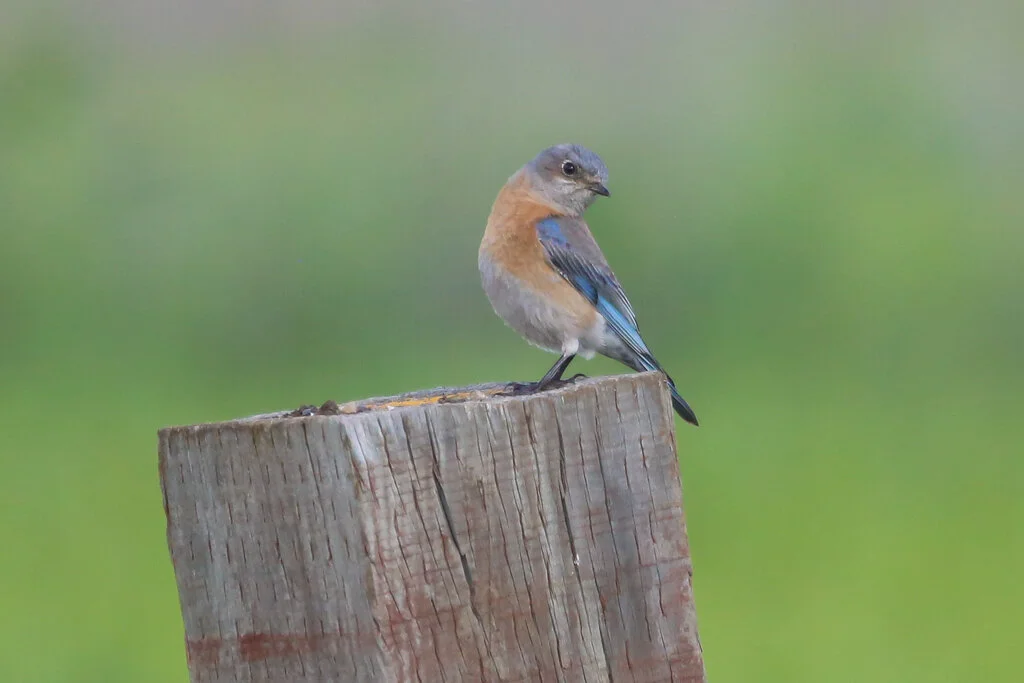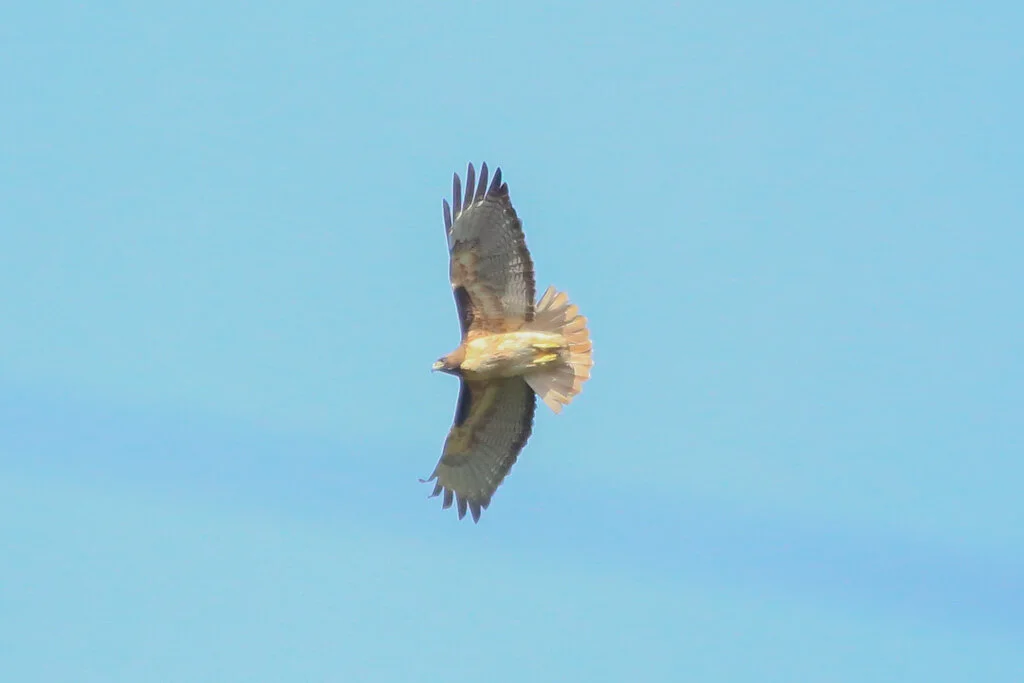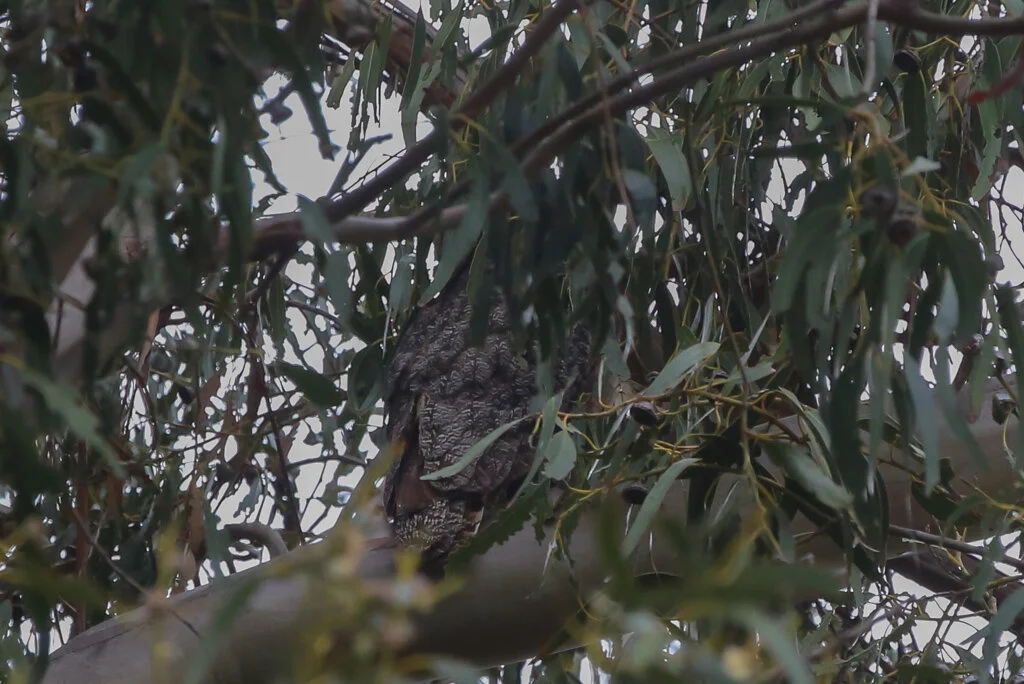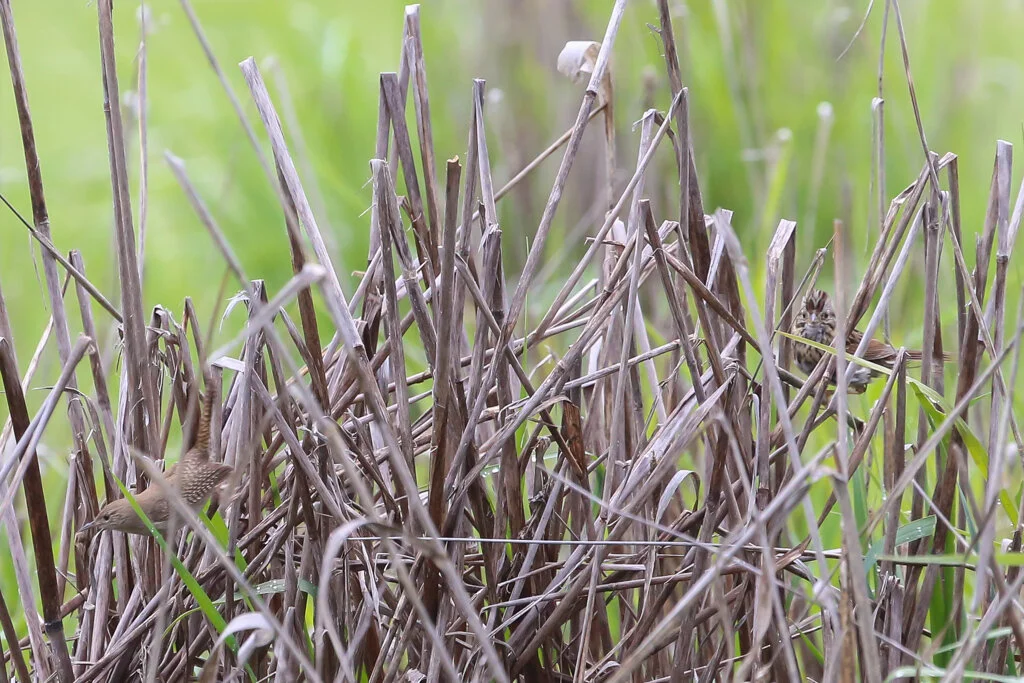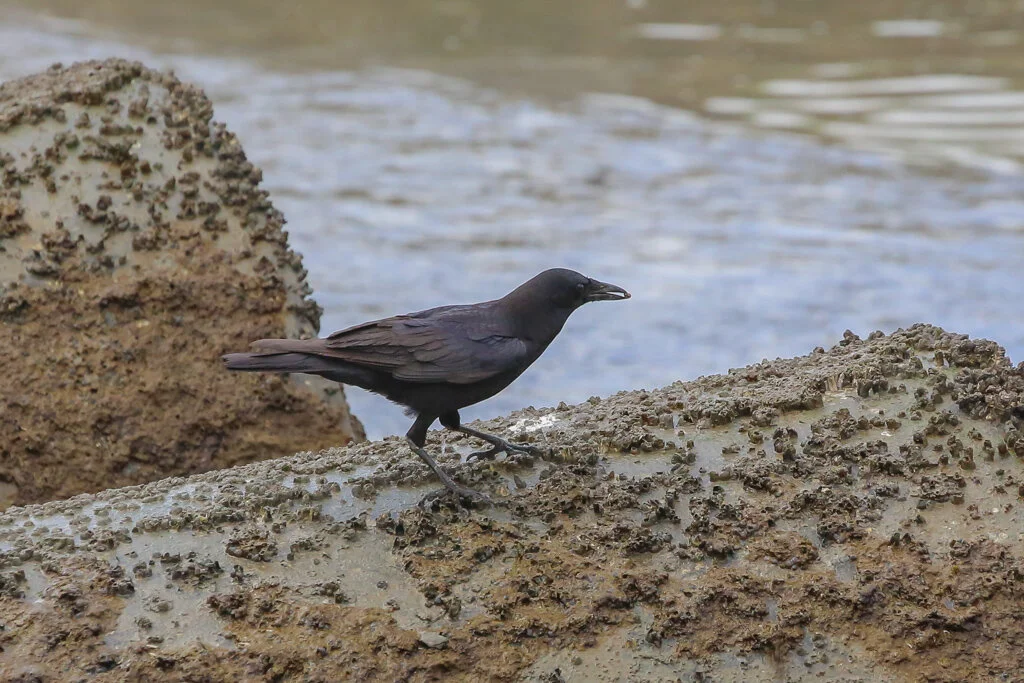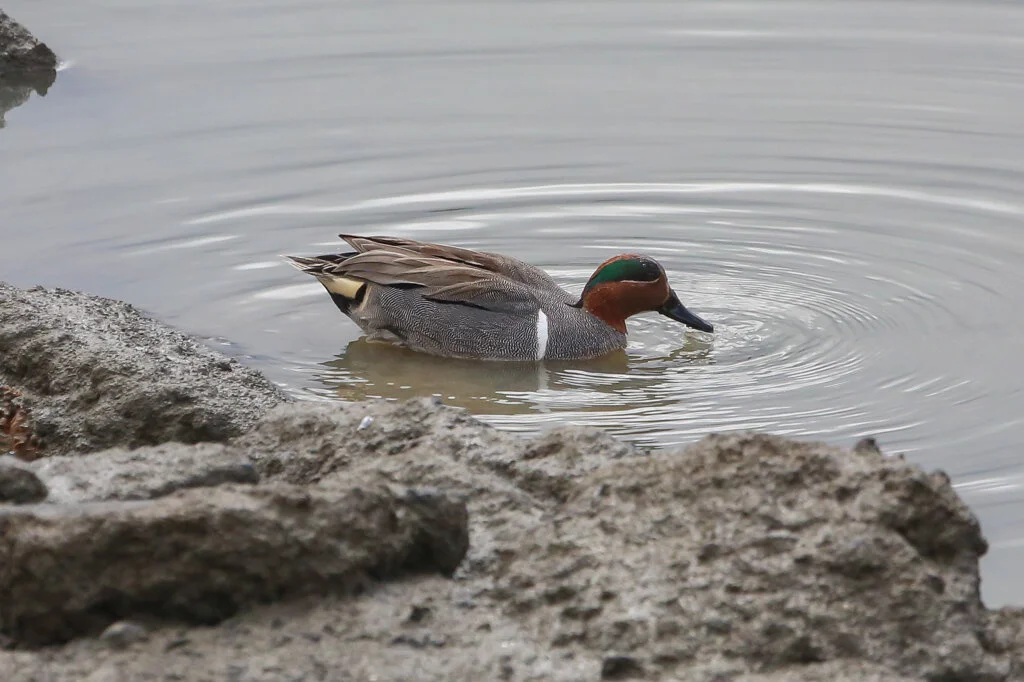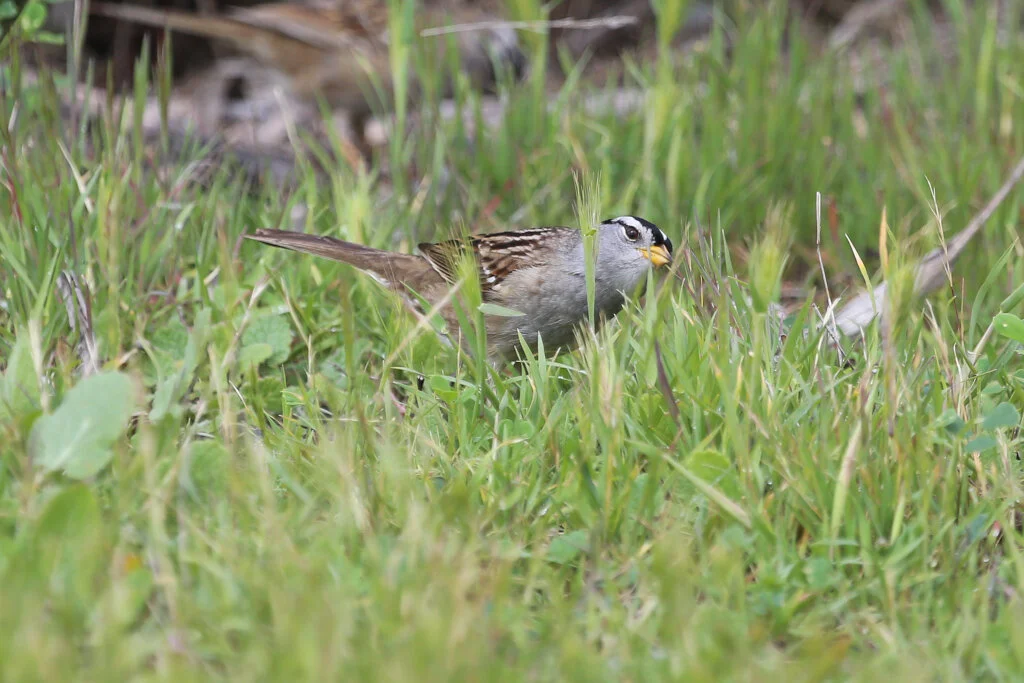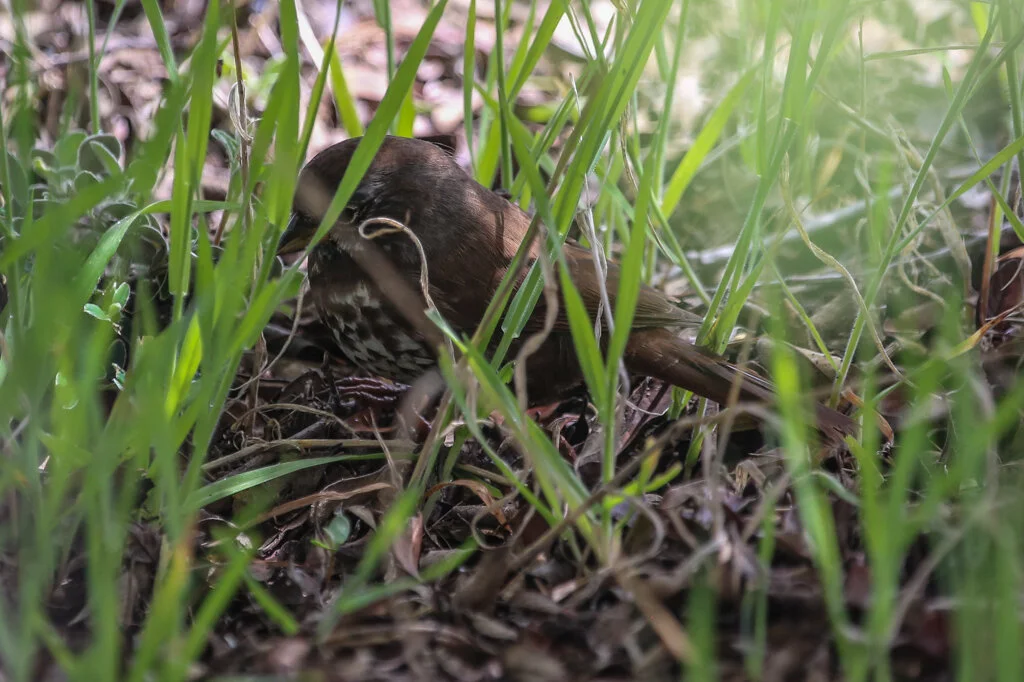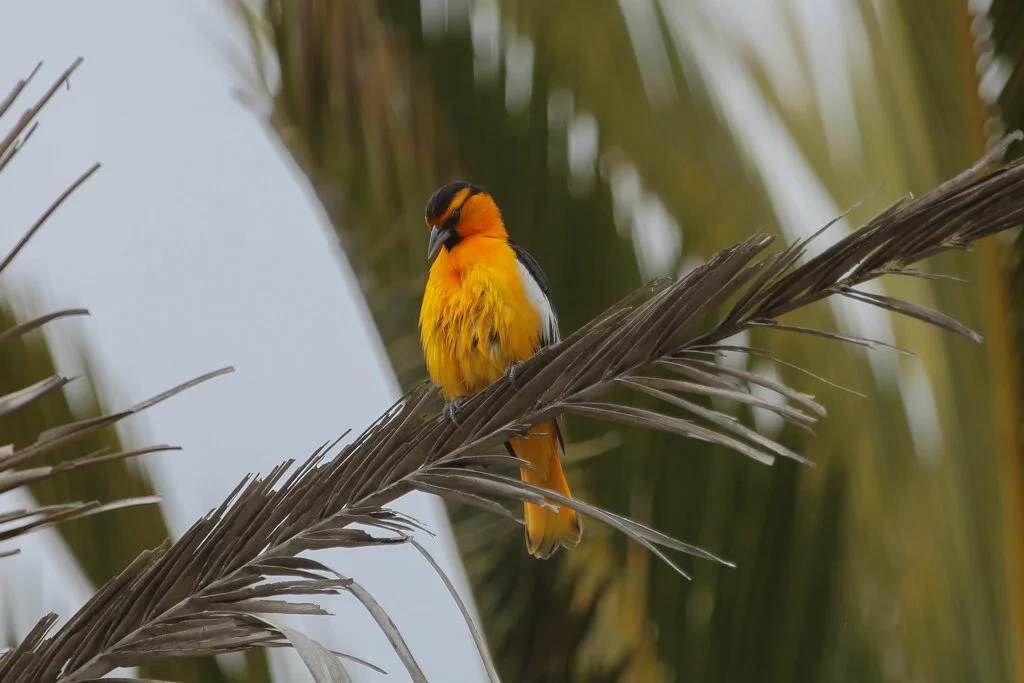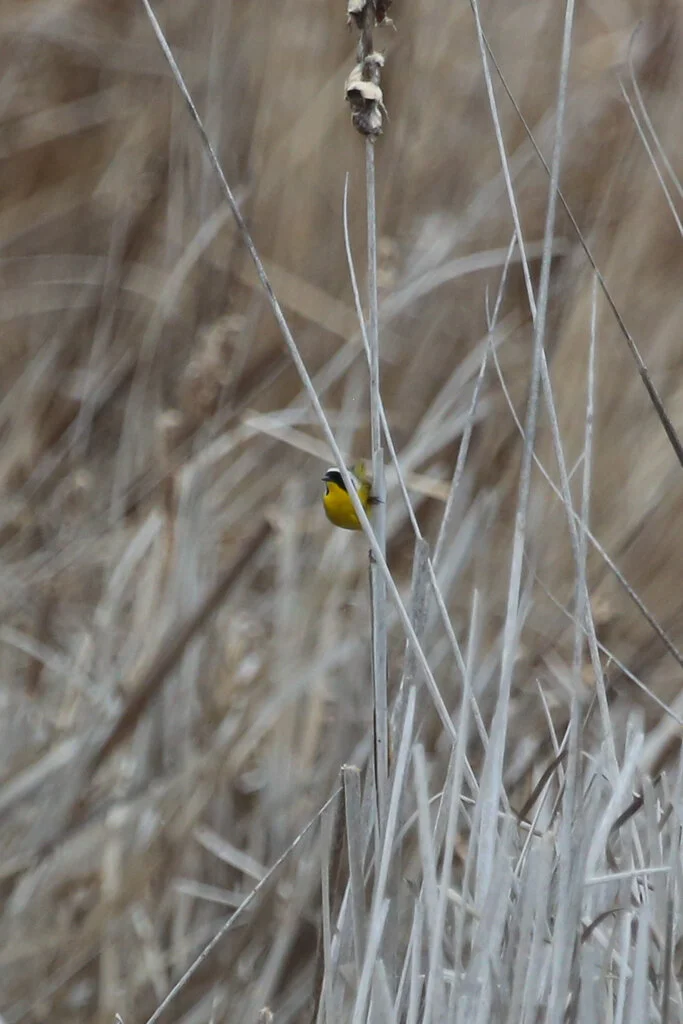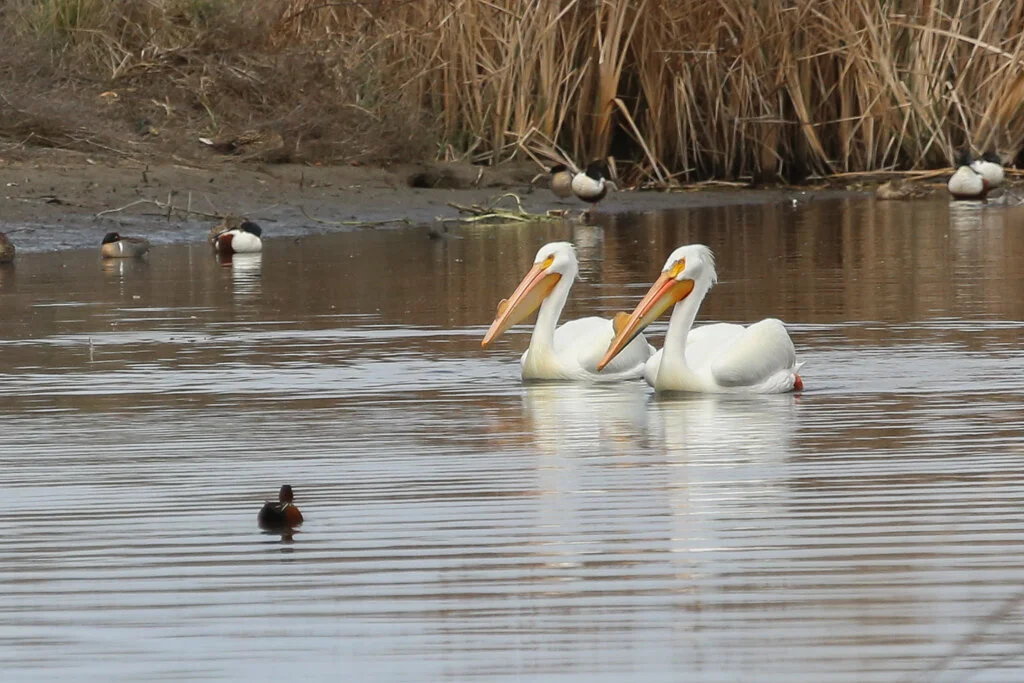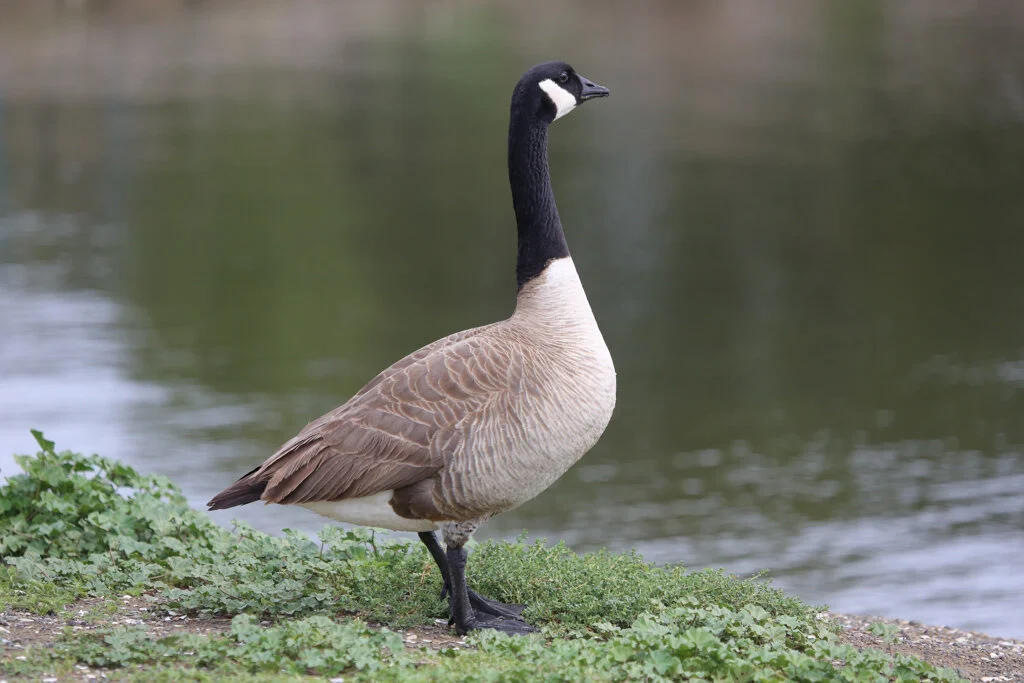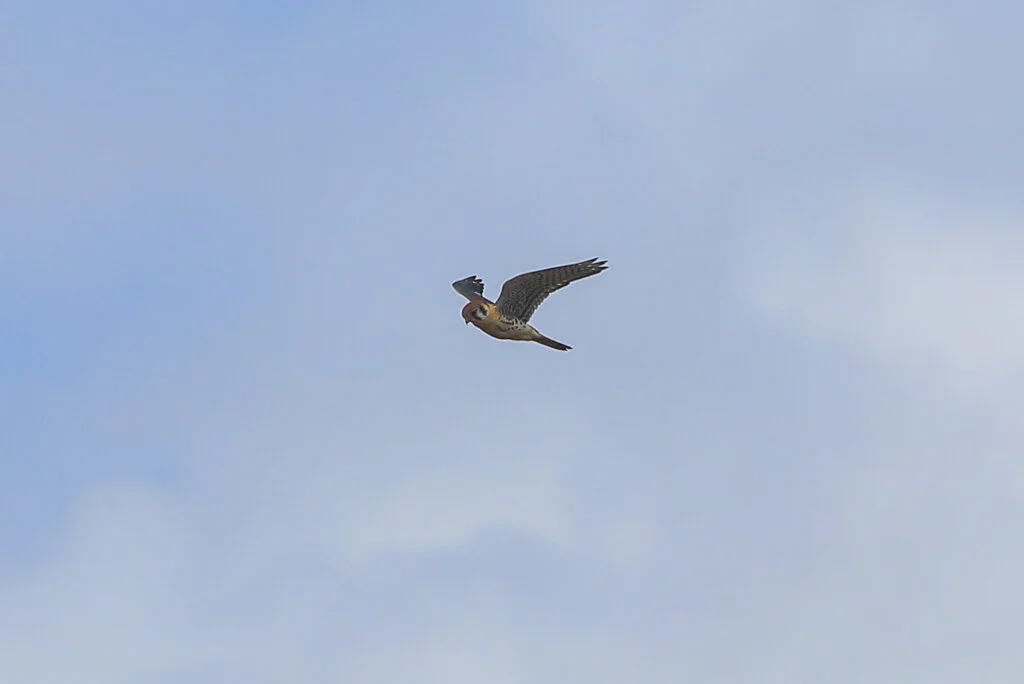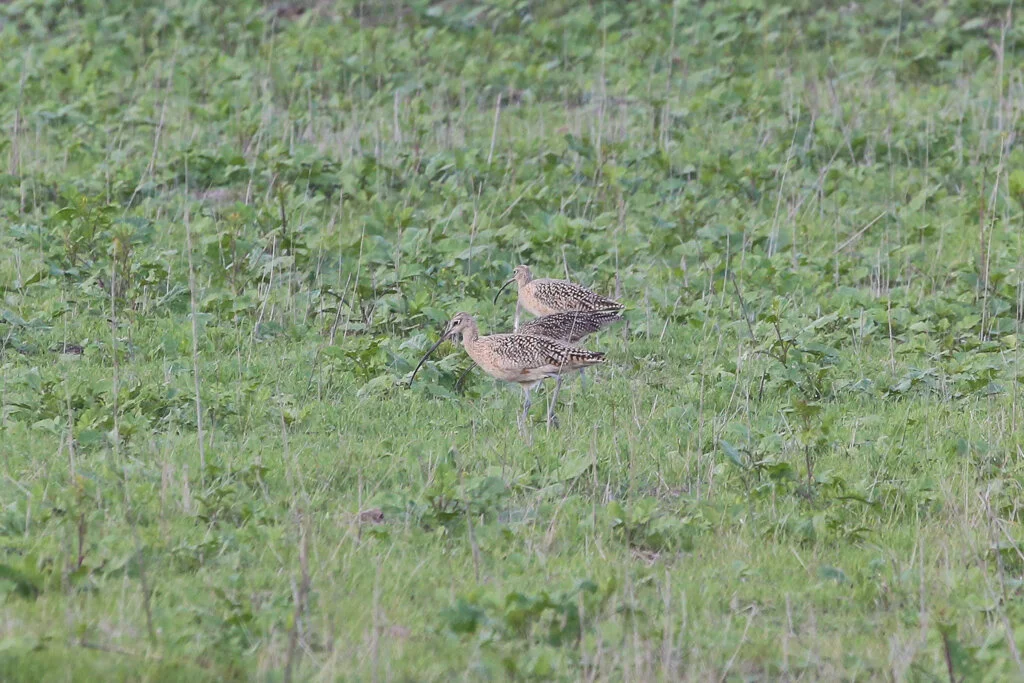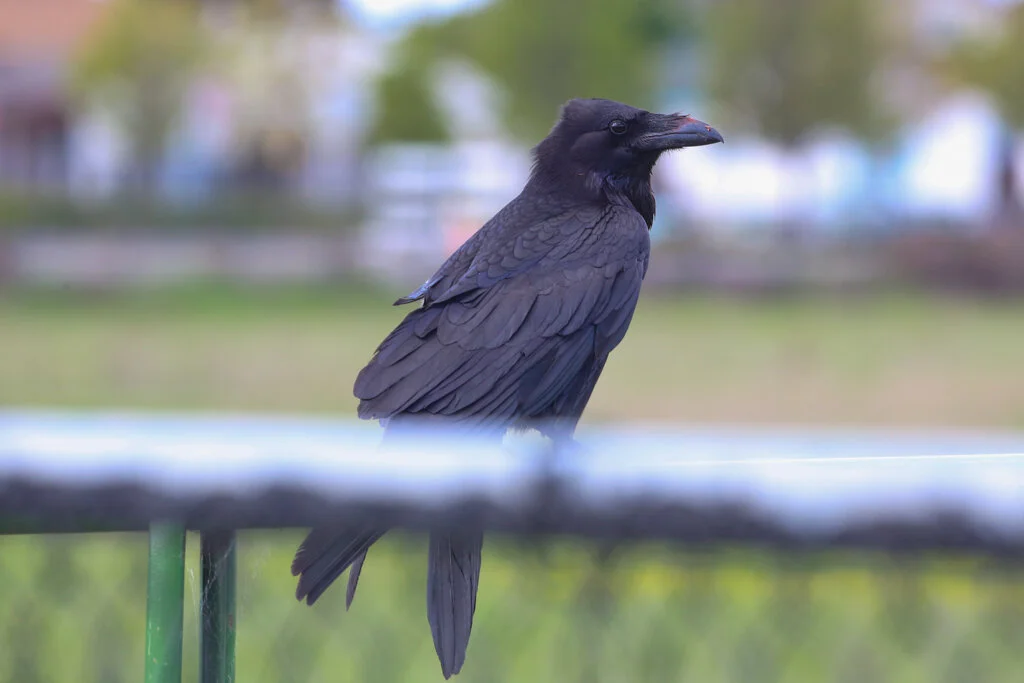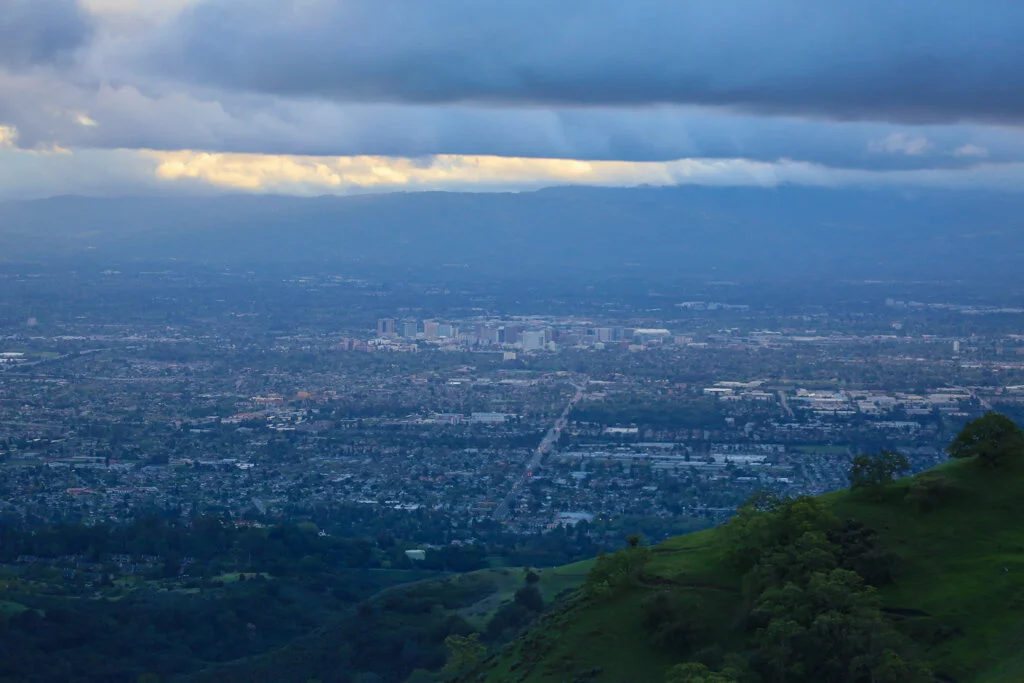The Jack Sparrows Birdathon - Friday 4 April 2014
Barry & Ginger Langdon-Lassagne
All photos were taken by Barry during the birdathon
The Start - Monte Bello OSP
We were approximately twenty minutes into our hike in the dark on a dirt trail in Monte Bello Open Space Preserve along the ridge tops of the Santa Cruz mountains when the first rains of the day started down on us. It is from this point, or nearby, that many birdathons start, as the location provides lovely habitat for birds that are difficult or impossible to find elsewhere in the county: several owls, Pileated Woodpeckers, Pacific Wren, and on clear calm mornings it is one of the best places to hear the dawn chorus as the birds greet the new day. This day was calm, but certainly not clear, and the dawn chorus was meagre, but even as the rain started to seep into our clothes our spirits were anything but damp.
We were on the border of Santa Clara and San Mateo Counties. Any bird we heard behind us could be out-of-county and wouldn’t count. In addition, the ridge to our right (southeast) marked the border of Santa Cruz County, so if a bird were heard too far off in that direction, it also would not count for the birdathon. Our first bird heard, from this grassy vantage point, was the distant booming of a Great Horned Owl. It was calling from the wooded valley below, safely within our home county. Delighted to have such a majestic bird as our first species, we headed excitedly down the trail to where it dropped into oaks and bay forest, giving us some shelter from the cold drizzle, and met up with the headwaters of Stevens Creek, whose flow is just a trickle this high up, even with the rain feeding it. It would be more than a half hour before we heard our next identifiable bird call.
When planning a birdathon route, we have “target birds” for a given habitat. Pacific Wren was one of our target birds for this location. We had gone scouting here with our daughters the previous week, and had found (and even photographed) two Pacific Wrens on this very trail. This time it was too dark and rainy to attempt any kind of photography. Luckily, the Pacific Wren has a loud, distinctive and delightful song that echoes the tinkling of the stream, and we heard it on several occasions as we hiked along.
Deeper into the preserve the dawn finally started to show through the clouds and we started to see as well as hear the birds around us. The rain had been coming down steadily for over an hour and we were soaked, especially our socks and shoes. My camera was still tucked safely into my daypack; I was waiting for to rain to let up, as well as for the dark to diminish, before beginning the photography part of our expedition.
We reached a stretch of trail where the birds were singing in large numbers; many we could recognize instantly, but many were also eluding us. Ginger’s ear is better than mine and she was eagerly identifying the calls by comparing against recordings we had on our phones. That was when we heard the Pileated Woodpecker. The Great Horned Owl called a few more times as well. And the songbirds were coming out in greater numbers. The rain let up long enough that I felt comfortable leaving my camera out, and I was able to begin taking pictures.
Townsend’s Warbler
Spotted Towhee
Blue-gray Gnatcatcher
But it was wet out. Wet. Wet. Wet.
Arastradero Preserve
Western Bluebird
Red-tailed Hawk
We drove down out of the Santa Cruz mountains to our next stop: Arastradero Preserve. Our strategy here was to scope Felt Lake from the trail and to get a few grassland birds on the hike. The sky had cleared, it was even sunny! I grabbed my spotting scope out from the trunk and we headed up the hill. A Grasshopper Sparrow surprised us by calling in the grass; we weren’t expecting to get this bird here, and it even flew out long enough for us to get a glimpse (but not a photo) of it. The Savannah Sparrows were much more photogenic.
Savannah Sparrow
Violet-green Swallow
White-throated Swift
White-throated Swifts and Violet-green Swallows soared over our heads. Warblers and sparrows abounded. Hummingbirds were guarding the blooming eucalyptus trees, and then we heard the booming of a Great Horned Owl again. We spent quite a bit of time hunting for him, and finally we were rewarded with a view of his lower half well up in the eucalyptus tree.
Great Horned Owl roosting in a eucalyptus
It started to rain again as we scaled the hill, and to my dismay I dropped my scope in the mud on the trail, twice! But it was none the worse for wear and we were able to identify Ring-necked Ducks and Bufflehead on Felt Lake, two birds we would not see elsewhere on this day.
After the lake, we tracked down a calling House Wren, and when I started to take its photo, a Lincoln’s Sparrow popped up into the same batch of grass and photobombed the wren! We were delighted to get Lincoln’s Sparrow as that’s another rarity that we would not see again that day.
Lincoln’s Sparrow in the reeds
We hiked back down to the parking lot. The rain had let up again, so we decided to risk changing into our spare sets of dry shoes and clothes before heading out to the baylands.
Red-tailed Hawk
Acorn Woodpecker on palm snag
Lesser Goldfinch
The Baylands
Western Gull
The nice thing about the baylands is that the birds are active all day, weather and tides permitting. Forest birds are active in the morning and evenings for the most part, so we time our route such that we are along the bay for the middle chunk of the day. We take whatever tide we can get though, as our busy schedules often don’t let us optimize for that. We were fortunate that this time we had a nice low tide, which meant that the shorebirds were out hunting in the mud, within easy binocular view.
American Crow
Northern Harrier
Green-winged Teal
Willet
Ruddy Duck
Snowy Egret
European Starling
Northern Mockingbird
American White Pelican
White-crowned Sparrow
House Finch
American Avocets (and one Willet, bottom and two Marble Godwits, mixed in)
We went counter-clockwise along the bottom of the bay, stopping at Palo Alto Baylands, Charleston Slough and Sunnyvale Baylands. We saw many great birds. Some highlights were White Pelicans soaring over the bay, a distant Golden Eagle (our second of the day), Black Skimmers with their ridiculous “Kandy Korn” bills, an elusive Fox Sparrow lurking in the grass under a bush, and glimmering Anna’s Hummingbirds feeding on the planted flowers near the ranger house.
Bald Eagle
Fox Sparrow
A pair of Black Skimmers, with some American Avocets
Bullock’s Oriole
Common Yellowthroat
Willet
A Pair of American White Pelicans
Western Grebe
Canada Goose
Northern Flicker
Anna’s Hummingbird
Anna’s Hummingbird
The Town of Alviso
Our last stop along the bottom of the bay was the town of Alviso. We were somewhat disappointed at how easy it was to find a Eurasian Collared Dove. This bird is a fairly new invader to the Bay Area, starting as captive birds that had escaped or were released into the wild. The first ones were discovered here around 2001; in 2007 they were still considered extreme rarities in the county. Now they are common in Alviso and spreading rapidly into surrounding areas. This is unfortunate, because this alien species may drive out native species as its population grows, potentially reducing the bird diversity in the area.
Eurasian Collared Dove
American Kestrel
At the Alviso Marina (now a county park and prime bird habitat) we found Horned Grebes and two species of falcon: American Kestrel and Peregrine Falcon. By the day’s end we saw a total of three Peregrines, much to our delight.
Western Kingbird
Nuttall’s Woodpecker
Long-billed Curlew
Common Raven
In Alviso, we found a parking spot near “Disk Drive” where we found a Nuttall’s Woodpecker and an unexpected Western Kingbird, but our target bird for this area was the Burrowing Owl. This little diurnal owl is very specific in the habitat it prefers, and the open fields here are one of the fairly reliable places to find them. Unfortunately, we were not able to find any, despite walking two miles around the field and spotting dozens of ground squirrels, many of which were doing their best “burrowing owl” impression. We did get some great views of Long-billed Curlews and their cousins the Whimbrel though. And there was a big old Raven watching us from the top of a cattle gate.
The East Hills
After the baylands we headed to the East Hills, starting with a stop at Ed Levin County Park where we found turkeys and more hawks, and we watched a Great Blue Heron very patiently waiting for a gopher to appear from its den. We were not patient enough to see the outcome of his waiting, as we wanted to get deeper into the hills before we lost our light.
Great Blue Heron
Ed Levin Park is another spot where we were near the border of two counties. To our north, still in the park boundaries, was Alameda County. We were in no danger of spotting birds out of county here though, as the boundary was more than a mile north of us. It is interesting that our travels brought us so close to three other counties, and yet we still managed to visit only a tiny percentage of Santa Clara County. We would not be traveling to the back side of Mount Hamilton (bordering Stanislaus County) or south to Gilroy (which borders San Benito as well as Santa Cruz Counties and is not far from Merced County), despite many excellent rarities to be found in those locations, as there just aren’t enough daylight hours to cover the full range of our large, diverse home county.
Peregrine Falcon
White-tailed Kite
On Marsh Road, just south of the Calaveras Reservoir, we hoped for Lark Sparrows and Horned Larks, but never found them. Nor could we find the Bald Eagle that is supposed to be nesting near the reservoir. We did get amazing looks at a Peregrine Falcon, saw Red-tailed Hawks hunting, found our Yellow-billed Magpies and picked up a Cassin’s Vireo, so we called it a win. Also, this is one of the most beautiful wild places in the county — it’s hard to believe you’re in the Bay Area when winding along the lonely backroads of the east hills. It was getting late now, the weather started getting cold and wet again, and the birds were fewer and farther between. We spotted a cat and a goat, but they didn’t count for our totals :-). It was time to start wrapping up the day.
Our last stop in the hills was Sierra Road. This is a favorite spot not just for the grassland species that are rare elsewhere, but because its position on the top of the hill makes it a place where migrant songbirds and hawks pass by and sometimes stop to rest. This is where, on my first birdathon in 2004, I found the rarest bird of the year: Lapland Longspur in full breeding plumage, a very long way from Lapland :-). Today was not a day for rarities, as the wind and the rain had whipped up again, making it a dismal spot to find any birds. We got no new species on the hilltop; almost no birds at all, just a family of four Ravens dancing across the gray skies.
Common Raven
Downtown San Jose, viewed from Sierra Road
End of Day Strategy
On the way down the hill we strategized: What hadn’t we seen? What could we hope for? We decided to hike the Sunnyvale Water Pollution Control Plant and neighboring salt ponds in hopes of a Brown-headed Cowbird, a Green Heron, a Bittern or a Rail. All we got for our two and a half mile hike was a great look at a young skunk, who ran away on the trail and desperately tried to scale a water pipe to escape from us.
Striped Skunk
One Last Stop
Our last hope was the Lucky’s parking lot in Sunnyvale, where we knew Brown-headed Cowbirds frequent, and Herring and other Gulls sometimes hang out on the lampposts. But, apparently, they only do so in the daytime, and it was after 9pm. And we were tired, achy, wet and cold. It was time to call it a night.
When we got home, we noticed that our legs were unusually sore. I thought that we had only hiked about five miles total, but Ginger calculated up the totals: 3 miles at Monte Bello, 3 more miles at Palo Alto Baylands and Charleston Slough. Over a mile at Sunnyvale Baylands. Over two miles in Alviso, etc. By the time we totaled it all up, we discovered that we had hiked over thirteen miles for the day.
Our daughters welcomed us home. We ate a late dinner. And we went to bed.
Places We Birded
Our writeup for the South-Bay-Birds email list:
The Jack Sparrows Birdathon - writeup for South Bay Birds email list - Friday 4 April 2014
Barry & Ginger Langdon-Lassagne
Ginger and I (The Jack Sparrows) braved the rain showers and the chill on Friday to total 122 birds, despite the elements. I managed to photograph 107 of those species; I'll post a link to the pictures after I’ve finished processing. Here are some highlights of our day:
We started at 5:30am on the Stevens Creek Nature Trail in Monte Bello Open Space Preserve, where our first bird of the day was a GREAT HORNED OWL calling out from the valley below. The first rain of the day started as we entered the forest canopy. Along the creek we heard PACIFIC WREN loudly singing in at least two locations, one just after the creek crossing before the intersection with the Skid Road Trail, and another halfway along the Skid Road Trail toward the Canyon Trail. We also heard several PACIFIC-SLOPE FLYCATCHERs along the creek. It wasn’t until we hit the Canyon Trail that the rain let up and it was light enough to photograph our first bird of the day: AMERICAN ROBIN.
On the Canyon Trail heading back toward Page Mill Road we heard an ASH-THROATED FLYCATCHER call, but never managed to see it. A distant unseen PILEATED WOODPECKER called several times. The rain significantly quieted the dawn chorus. In the chaparral near Page Mill we got great views of a lovely BLUE-GRAY GNATCATCHER, followed by WESTERN BLUEBIRDs which helped us keep our spirits up in the drizzle.
At Arastradero Preserve, on the hillside on the eastern leg of the Redtail Loop Trail, we heard and saw a GRASSHOPPER SPARROW. Then it poured rain on us for a while. We made it to the line of eucalyptus trees where we found (and photographed) another GREAT HORNED OWL, and also found an adult male BULLOCK’S ORIOLE. Felt Lake had a small group of RING-NECKED DUCKS along the far shore, and several pairs of BUFFLEHEAD closer in. A GOLDEN EAGLE soared in front of the Stanford Dish. While taking a picture of a singing HOUSE WREN in the grasses, a LINCOLN’S SPARROW jumped up and photo-bombed me! Across the street from the parking area, as we changed out of our muddy shoes and wet clothes, we enjoyed the complex, often-mimicking song of a CALIFORNIA THRASHER.
At Palo Alto Baylands we found GREATER SCAUP in the duck pond. In the slough by the parking area at the Lucy Evans nature center we found a pair of CANVASBACK and a pair of AMERICAN WIGEON. A NORTHERN HARRIER hunted overhead. A FOX SPARROW scratched under the chaparral between the ranger station and the slough, giving me a chance to photograph him. Selasphorus hummingbirds (probably ALLEN’s) flew around in the eucalyptus by the ranger station. We couldn’t walk the boardwalk as it was closed for safety reasons, so we tried to scope the bay, but from that distance could only clearly identify AMERICAN WHITE PELICANs.
In the distance we saw an additional GOLDEN EAGLE at the Emily Renzel Wetlands.
At Charleston Slough, we found five BLACK SKIMMERs on the island by the observation deck.
At Sunnyvale Baylands park we hiked to the boardwalk, where a SAY’S PHOEBE posed for a lovely portrait, in the open field behind the Twin Creeks baseball complex.
At the end of the boardwalk at Alviso Marina County Park we scoped for grebes. There were dozens of EARED GREBES, but we did not find any horned. There were also quite a few LESSER SCAUP. An AMERICAN KESTREL hovered over the wetlands, and a PEREGRINE FALCON flew past.
In Alviso, at the intersection of Grand Boulevard and Disk Drive we found a WESTERN KINGBIRD, and further down Disk Drive in the fields were about a dozen LONG-BILLED CURLEWs. While photographing the curlews, a flock of 11 WHIMBRELs flew overhead, conveniently; easier to compare and contrast them like that!
On Calaveras Road, on the way up to Ed Levin, we stopped along the roadside and saw COOPER’S HAWK, BLACK-HEADED GROSBEAK, WILSON’S WARBLER and heard a ROCK WREN.
Then we drove up to Ed Levin County Park, where we found more Selasphorus hummingbirds and got our only PIED-BILLED GREBE of the day. The drive down Marsh Road gave us CASSIN’S VIREO, YELLOW-BILLED MAGPIE and another PEREGRINE FALCON. We were stormed upon one last time at the summit of Sierra Road, where the birds had the sense to stay in more sheltered places than a ridge top with drenching rain and high winds.
We drove to the Sunnyvale Water Pollution Control Plant and Baylands Trail for one last hike before the light failed us, hoping for green heron. There were no new birds as darkness descended, but we did flush a young skunk, who scampered away from us down the trail. And, lastly, we tried for our missing cowbird or maybe a herring gull in their usual hangout — the Lucky’s parking lot in Sunnyvale — but the birds had long-since gone to sleep. We took the hint and went home ourselves at 9:30pm.
Barry & Ginger Langdon-Lassagne
The Jack Sparrows
~
Jack Sparrows Bird List in AOU Order
|
|
Jack Sparrows Bird List in AOU Order |
|
√ |
Canada Goose |
|
√ |
Gadwall |
|
√ |
American Wigeon |
|
√ |
Mallard |
|
√ |
Cinnamon Teal |
|
√ |
Northern Shoveler |
|
√ |
Green-winged Teal |
|
√ |
Canvasback |
|
√ |
Ring-necked Duck |
|
√ |
Greater Scaup |
|
√ |
Lesser Scaup |
|
√ |
Surf Scoter |
|
√ |
Bufflehead |
|
√ |
Ruddy Duck |
|
h |
California Quail |
|
h,√ |
Wild Turkey |
|
√ |
Pied-billed Grebe |
|
√ |
Eared Grebe |
|
√ |
Western Grebe |
|
√ |
American White Pelican |
|
√ |
Double-crested Cormorant |
|
√ |
Great Blue Heron |
|
√ |
Great Egret |
|
√ |
Snowy Egret |
|
√ |
Black-crowned Night-Heron |
|
√ |
Turkey Vulture |
|
√ |
White-tailed Kite |
|
√ |
Northern Harrier |
|
√ |
Cooper's Hawk |
|
h |
Red-shouldered Hawk |
|
√ |
Red-tailed Hawk |
|
√ |
Golden Eagle |
|
√ |
American Kestrel |
|
√ |
Peregrine Falcon |
|
√ |
Common Gallinule |
|
√ |
American Coot |
|
h,√ |
Killdeer |
|
√ |
Black-necked Stilt |
|
√ |
American Avocet |
|
√ |
Greater Yellowlegs |
|
√ |
Willet |
|
√ |
Whimbrel |
|
√ |
Long-billed Curlew |
|
√ |
Marbled Godwit |
|
√ |
Western Sandpiper |
|
√ |
Least Sandpiper |
|
√ |
Dunlin |
|
√ |
Long-billed Dowitcher(or Short-billed) |
|
√ |
Ring-billed Gull |
|
√ |
Western Gull |
|
√ |
California Gull |
|
h,√ |
Forster's Tern |
|
√ |
Black Skimmer |
|
√ |
Rock Pigeon |
|
h,√ |
Band-tailed Pigeon |
|
√ |
Eurasian Collared-Dove |
|
√ |
Mourning Dove |
|
h,√ |
Great Horned Owl |
|
√ |
White-throated Swift |
|
√ |
Anna's Hummingbird |
|
h,√ |
Allen's Hummingbird?(or Rufous) |
|
h,√ |
Acorn Woodpecker |
|
h,√ |
Nuttall's Woodpecker |
|
h,√ |
Hairy Woodpecker |
|
h,√ |
Northern Flicker |
|
h |
Pileated Woodpecker |
|
h |
Pacific-slope Flycatcher |
|
√ |
Black Phoebe |
|
√ |
Say's Phoebe |
|
h |
Ash-throated Flycatcher |
|
√ |
Western Kingbird |
|
√ |
Cassin's Vireo |
|
h,√ |
Steller's Jay |
|
h,√ |
Western Scrub-Jay |
|
h,√ |
Yellow-billed Magpie |
|
h,√ |
American Crow |
|
h,√ |
Common Raven |
|
√ |
Violet-green Swallow |
|
√ |
Nor. Rough-winged Swallow |
|
√ |
Cliff Swallow |
|
√ |
Barn Swallow |
|
h,√ |
Chestnut-backed Chickadee |
|
h,√ |
Oak Titmouse |
|
h,√ |
Bushtit |
|
h |
Red-breasted Nuthatch |
|
h,√ |
Brown Creeper |
|
h |
Rock Wren |
|
h,√ |
Bewick's Wren |
|
h,√ |
House Wren |
|
h |
Pacific Wren |
|
h |
Marsh Wren |
|
h,√ |
Blue-gray Gnatcatcher |
|
√ |
Western Bluebird |
|
h |
Hermit Thrush (or Swainson's) |
|
√ |
American Robin |
|
h,√ |
Northern Mockingbird |
|
h |
California Thrasher |
|
√ |
European Starling |
|
h,√ |
Orange-crowned Warbler |
|
h,√ |
Yellow-rumped Warbler |
|
h,√ |
Townsend's Warbler |
|
h,√ |
Common Yellowthroat |
|
√ |
Wilson's Warbler |
|
h,√ |
Spotted Towhee |
|
h,√ |
California Towhee |
|
√ |
Savannah Sparrow |
|
h,√ |
Grasshopper Sparrow |
|
√ |
Fox Sparrow |
|
h,√ |
Song Sparrow |
|
√ |
Lincoln's Sparrow |
|
h |
White-crowned Sparrow |
|
√ |
Golden-crowned Sparrow |
|
h,√ |
Dark-eyed Junco |
|
√ |
Black-headed Grosbeak |
|
√ |
Red-winged Blackbird |
|
h |
Western Meadowlark |
|
√ |
Brewer's Blackbird |
|
√ |
Bullock's Oriole |
|
h |
Purple Finch |
|
√ |
House Finch |
|
h,√ |
Lesser Goldfinch |
|
√ |
House Sparrow |
Key:
√ = seen
h = heard
h,√ = heard first, later seen
Original welcome letter:
Santa Clara Valley Audubon Society Spring Birdathon 2014
Dear friends, family and colleagues,
The lack of rain and the early warmth has made this a strange spring for birds, but that isn’t going to stop us from heading out yet again in support of the Santa Clara Audubon Society. And this year I’m no longer suffering from back problems, so The Jack Sparrows (that’s Ginger and me) will be doing a full day (pre-dawn to after dark) epic Birdathon this year.
This year we are heading out on Friday, April 4th. As usual, we plan to hit as many different habitats as possible, all while keeping within the county boundaries and the 24-hour time limit. Because of the unusual winter weather (drought and warmth), we have no idea what the birding is going to be like. Winter birds may be gone, migrants may have already passed through, Summer birds might not be here yet. Who knows? Whatever the birds decide, we have goals of observing at least 120 species and photographing 100 or more species.
If you’d like to help, please consider sponsoring our team (The Jack Sparrows), or Ginger or Barry individually. All donations go to help the Santa Clara Valley Audubon Society's (SCVAS's) science education programs and conservation efforts. All pledges are tax deductible, as the Santa Clara Valley Audubon Society is a 501(c)(3) non-profit organization. For more information, go to the Santa Clara County Audubon Society's birdathon page. If you would like to support this cause, you can send Barry email pledging an amount per species (e.g. 25¢/species seen or species photographed) or a fixed amount or any special pledges (e.g. $1 for every bird of prey, etc.). You can also donate via PayPal by clicking the "Donate Now" button.
Last year we ranked seventh in raising money to support the Audubon Society. In 2012 and 2011 Barry won awards for the most species photographed. Read about Last year's official results on the SCVAS website.
Our previous years' adventures are documented at http://www.voyageropen.org/nature/birding/. Here's a summary:
2013: The Jack Sparrows did a short 4-hour birdathon, identifying 92 species and photographing 64 species
2012: Barry birded with the Varied Twitchers, identified 170 species and photographed a record 125 species
2011: The Jack Sparrows again competed, saw 118 species and photographed 99 species
2010: The Jack Sparrows return to find 119 species
2009: Barry birded with the Varied Twitchers, but only got a half-day in as he was sick (120 species)
2008: The Jack Sparrows won the "most eco-friendly" birdathon category (129 species)
2007: Second birdathon for the Jack Sparrows (126 species)
2006: The Jack Sparrows' first birdathon (125 species)
2005: The Varied Twitchers birdathon (157 species)
2004: Barry's first birdathon was with the Varied Twitchers in 2004 (158 species)
Thank you for all your support in years past and we are excited about another fun birding adventure this year.
Barry & Ginger Langdon-Lassagne
The Jack Sparrows!


